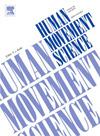Transfer of motor learning in a motion-controlled video game is better facilitated using rotations of the torso rather than movements of the center of pressure as a controller
IF 1.9
3区 心理学
Q4 NEUROSCIENCES
引用次数: 0
Abstract
Despite growing interest in motion-controlled video games for rehabilitation, the mechanisms that facilitate transfer of motor learning in such situations remain poorly understood. This study examined the transfer of motor learning in a video game task controlled either via center of pressure (CoP) displacement or through torso rotations. For this purpose, during the game, participants controlled an aircraft in vertical and horizontal axes and had to fly through 100 ring-shaped targets. Twenty-one participants were randomly divided into two experimental groups. The first group (CoP-Tor) played first the game controlling the aircraft with CoP displacements and then the one with torso rotations. The second group (Tor-CoP) played the games in reverse order. Spatial errors were calculated between the player's position and the targets to quantify game performance. Sample entropy of the CoP displacement was calculated to quantify repeatability in postural sway variability. Our results showed that spatial errors were significantly lower in the CoP-controlled game for the Tor-CoP group compared to the CoP-Tor group. The Tor-CoP group also exhibited lower repeatability values in the CoP-controlled game compared to the CoP-Tor group. Our results suggested a directional transfer of motor learning from the Tor-controlled game to the CoP-controlled game, because performance improved in the CoP-controlled game when it was played after a Tor-controlled game. The entropy results suggested that the improved CoP-controlled game performance was also followed by a more repeatable pattern of movement variability. Overall, our findings suggest that torso-related training can improve CoP control possibly by increasing the repeatability of movement variability.
在动作控制的视频游戏中,使用躯干的旋转而不是作为控制器的压力中心的运动,更容易促进运动学习的转移
尽管人们对运动控制的视频游戏在康复治疗中的作用越来越感兴趣,但在这种情况下促进运动学习转移的机制仍然知之甚少。本研究考察了通过压力中心(CoP)位移或躯干旋转控制的视频游戏任务中运动学习的转移。为此,在游戏中,参与者在垂直和水平方向上控制一架飞机,并必须飞过100个环形目标。21名参与者被随机分为两个实验组。第一组(CoP- tor)首先玩的游戏是控制飞机的CoP位移,然后是躯干旋转。第二组(Tor-CoP)按相反的顺序玩游戏。通过计算玩家位置和目标之间的空间误差来量化游戏表现。计算CoP位移的样本熵以量化姿势摇摆可变性的重复性。我们的研究结果表明,Tor-CoP组在cop控制游戏中的空间错误明显低于CoP-Tor组。与CoP-Tor组相比,Tor-CoP组在cop控制的游戏中也表现出较低的重复性值。我们的研究结果表明,运动学习从tor控制的游戏向cop控制的游戏有方向性转移,因为在tor控制的游戏之后,cop控制的游戏的表现有所改善。熵值结果表明,改进的cop控制的游戏表现也伴随着更可重复的移动可变性模式。总的来说,我们的研究结果表明,躯干相关的训练可能通过增加运动可变性的可重复性来改善CoP控制。
本文章由计算机程序翻译,如有差异,请以英文原文为准。
求助全文
约1分钟内获得全文
求助全文
来源期刊

Human Movement Science
医学-神经科学
CiteScore
3.80
自引率
4.80%
发文量
89
审稿时长
42 days
期刊介绍:
Human Movement Science provides a medium for publishing disciplinary and multidisciplinary studies on human movement. It brings together psychological, biomechanical and neurophysiological research on the control, organization and learning of human movement, including the perceptual support of movement. The overarching goal of the journal is to publish articles that help advance theoretical understanding of the control and organization of human movement, as well as changes therein as a function of development, learning and rehabilitation. The nature of the research reported may vary from fundamental theoretical or empirical studies to more applied studies in the fields of, for example, sport, dance and rehabilitation with the proviso that all studies have a distinct theoretical bearing. Also, reviews and meta-studies advancing the understanding of human movement are welcome.
These aims and scope imply that purely descriptive studies are not acceptable, while methodological articles are only acceptable if the methodology in question opens up new vistas in understanding the control and organization of human movement. The same holds for articles on exercise physiology, which in general are not supported, unless they speak to the control and organization of human movement. In general, it is required that the theoretical message of articles published in Human Movement Science is, to a certain extent, innovative and not dismissible as just "more of the same."
 求助内容:
求助内容: 应助结果提醒方式:
应助结果提醒方式:


